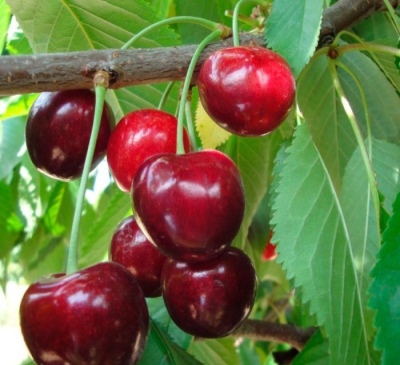
- Authors: A.F. Kolesnikova, E.N. Dzhigadlo, G.B. Zhdanova, A.V. Zavyalova, T.A. Trofimova (All-Russian Research Institute of Breeding of Fruit Crops)
- Appeared when crossing: Zhukovskaya x Dawn of the Volga region x Cinderella
- Year of approval: 2006
- Barrel type: wood
- Growth type: medium-sized
- Crown: spherical, weeping, drooping, medium density
- Escapes: medium, straight, brown
- Leaves: elongated oval, dark green, smooth, matte, concave
- Flowers: narrow-rounded, white
- Flowering and fruiting type: on annual growths and bouquet branches
Cherry Excellent Kolesnikova looks quite an attractive choice for many gardeners. But that is why you need to get acquainted with it better and find out the maximum of reliable information. With this approach, this representative of stone fruit crops is very productive.
Breeding history
Cherry Excellent Kolesnikova has been introduced into economic circulation since 2006. It was created by a complex crossing of the Volga Dawn, Zhukovskaya and Cinderella. The work was carried out at the All-Russian Research Institute of Breeding of Fruit Crops. The breeders were working on the project:
Jigadlo;
Kolesnikov;
Zavyalova;
Zhdanov;
Trofimova.
Description of the variety
Medium-sized cherries of the Excellent Kolesnikova reach a height of 2.5 m. The crown is close in shape to a simple ball. She is weeping and usually droops. The top of the tree is of medium density. They also note:
average size of straight brown shoots;
leaves in the form of an elongated oval;
foliage is dark green with a matte sheen;
white flowers in the form of a narrow glass;
3 flowers in each inflorescence.
Fruit characteristics
The dimensions of cherries are more often 1.8x1.6x1.5 cm, although there are also slightly different sizes. Their average weight is 3.9-4 grams. In shape, such drupes are most similar to an oval. The medium-sized stone separates well from the pulp. Red sap formation is characteristic.
Taste qualities
The share of dry matter is 16.92%. The concentration of sugars is 11.98%, and the proportion of acids is 1.36%. Tasters estimate the harvest in fresh condition at 4.6 points. In general, sweet and sour taste is typical for it.
Ripening and fruiting
The first crops are harvested in the 4th year of development. Normally, flowering lasts from 10 to 18 May. This crop has an average ripening period. Harvest time comes from 15 to 30 July. Weather conditions can greatly affect these times; fruits are formed both on growth and on skeletal branches.

Yield
On average, the collection can be 113 centners per hectare. The maximum recorded fertility is 203 centners per hectare. The amount of collection strongly depends on weather conditions and on competent agricultural technology. But in general, the plant is unpretentious and has a decent marketability.
Growing regions
The plant is officially zoned by:
Belgorod;
Kursk;
Voronezh;
Lipetsk;
Tambov regions.
Self-fertility and the need for pollinators
The official description emphasizes limited self-fertility. Therefore, cultivation of a plant without pollinators is in itself possible. However, achieving a decent result with this approach will not work.
Landing
Such cherries can be planted on loam. And also sod-podzolic soil, chernozem or light loam are suitable for it. A neutral chemical reaction is imperative. Stagnation of soil water is unacceptable. Spring planting is preferred.
You need to choose the right moment. It is better that the soil has already warmed up, and the buds have not yet blossomed. The acidic earth is preliminarily limed. This procedure must be completed before laying organic fertilizers. The introduction of lime into the planting pit itself is unacceptable - the roots may suffer.


Growing and care
The culture is hygrophilous. At the same time, intense sunlight is important for her. During the growing season, a couple of dressings are carried out. When flowering is over, the trees need to be watered thoroughly. The crown is systematically thinned out, focusing on the characteristics of the development of a particular plant. The distance is approximately 1.5 m.
When flowering, it is required to spray the branches with honey water. In the spring, such cherries must be cleaned (pruned). Sections and cracks need to be covered. Water the plant 3 times during the growing season. Copper sulfate or another preparation containing copper is used to protect against diseases.


Disease and pest resistance
The culture tolerates the defeat of moniliosis and coccomycosis relatively well. However, skillful handling and proper protection can achieve reliable protection. Aphids and flies should be suppressed by any means available.
Requirements for soil and climatic conditions
The cold resistance of this plant is at an average level. Wood resists frost well. However, the kidneys can be severely damaged when the winter weather worsens.
































































